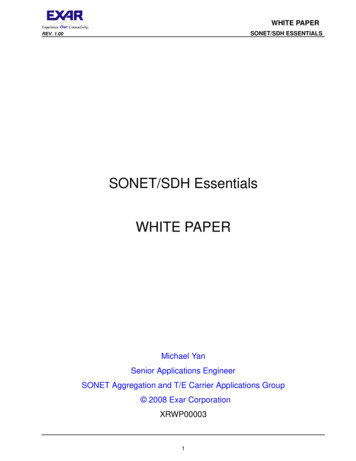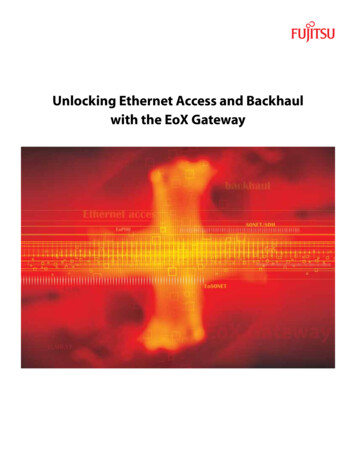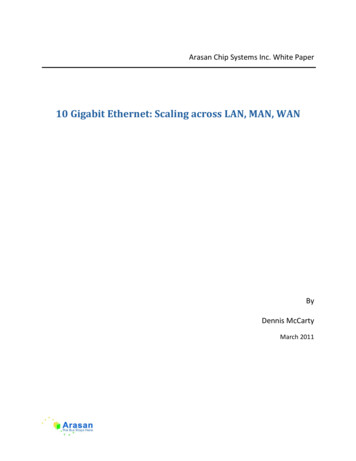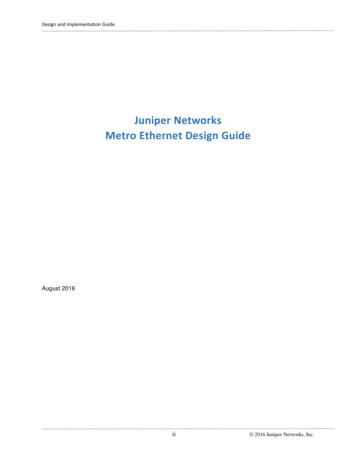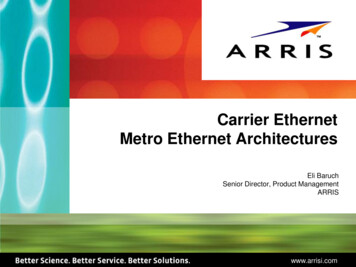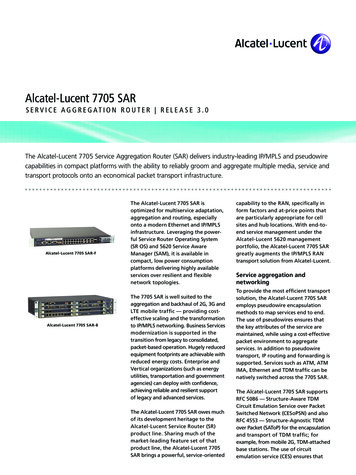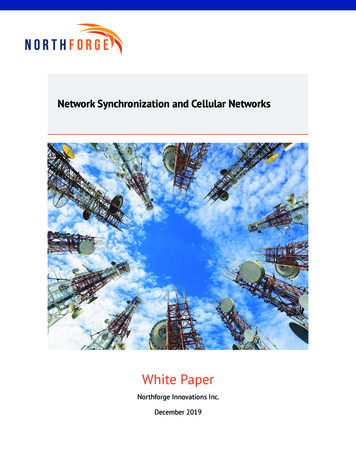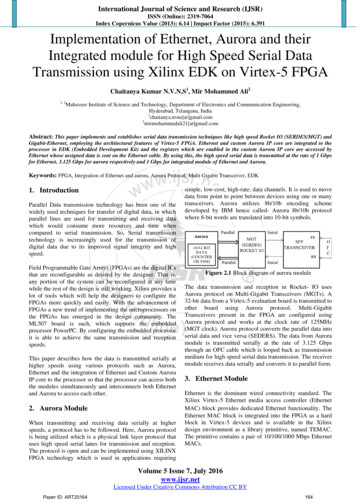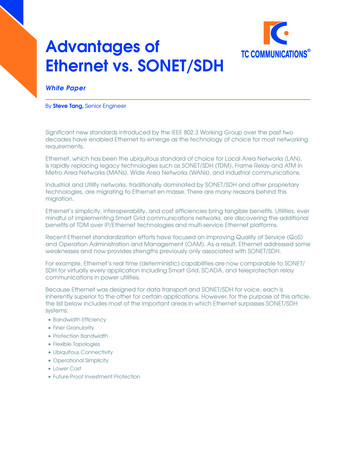
Transcription
Advantages ofEthernet vs. SONET/SDHWhite PaperBy Steve Tang, Senior EngineerSignificant new standards introduced by the IEEE 802.3 Working Group over the past twodecades have enabled Ethernet to emerge as the technology of choice for most networkingrequirements.Ethernet, which has been the ubiquitous standard of choice for Local Area Networks (LAN),is rapidly replacing legacy technologies such as SONET/SDH (TDM), Frame Relay and ATM inMetro Area Networks (MANs), Wide Area Networks (WANs), and industrial communications.Industrial and Utility networks, traditionally dominated by SONET/SDH and other proprietarytechnologies, are migrating to Ethernet en masse. There are many reasons behind thismigration.Ethernet’s simplicity, interoperability, and cost efficiencies bring tangible benefits. Utilities, evermindful of implementing Smart Grid communications networks, are discovering the additionalbenefits of TDM over IP/Ethernet technologies and multi-service Ethernet platforms.Recent Ethernet standardization efforts have focused on improving Quality of Service (QoS)and Operation Administration and Management (OAM). As a result, Ethernet addressed someweaknesses and now provides strengths previously only associated with SONET/SDH.For example, Ethernet’s real time (deterministic) capabilities are now comparable to SONET/SDH for virtually every application including Smart Grid, SCADA, and teleprotection relaycommunications in power utilities.Because Ethernet was designed for data transport and SONET/SDH for voice, each isinherently superior to the other for certain applications. However, for the purpose of this article,the list below includes most of the important areas in which Ethernet surpasses SONET/SDHsystems: Bandwidth Efficiency Finer Granularity Protection Bandwidth Flexible Topologies Ubiquitous Connectivity Operational Simplicity Lower Cost Future Proof Investment Protection
CellphonesT1EthernetCellphonesAggregation SiteT1Ethernet10/100/1000To Core NetworkCellphonesT1EthernetFigure 1: Ethernet Statistical Multiplexing CapabilityBandwidth EfficiencySONET/SDH networks are designed to use fixed bandwidth circuits which contribute to overallcomplexity and operation inefficiencies. In short, SONET/SDH bandwidth allocation is rigid;Ethernet is flexible.For example, users often over-subscribe to accommodate for traffic bursts during peak usage.This over-provisioning, combined with the network redundancy required for self-healing, resultsin inefficient use of available network capacity. In contrast, as shown in figure 1, the statisticalmultiplexing nature of traditional Ethernet provides more efficient network utilization for serviceproviders.The need for more bandwidth efficiency is most noticeable in mobile backhaul applications.Changing cell phone habits and the emergence of 4G technologies have triggered anexponential increase in data content for mobility backhaul. This has created an ongoingneed to add more transmission capacity. The rub is that voice centric SONET/SDH-basednetworks no longer offer a viable and cost-effective solution to handle the increase in datatraffic for backhaul transport.In the past, addressing increased voice traffic involved simply deploying larger number of T1/E1 circuits between the cell sites and the network core. The generous revenue stream fromthese voice calls easily justified the cost of additional T1/E1 circuits.In contrast, adding additional data traffic is more complex. Installing more T1/E1 circuits tohandle increased data traffic is not cost effective because data traffic generates a muchsmaller revenue stream per Mbit of traffic than voice. The cost effective solution is Ethernet.Ethernet is a connectionless packet technology that inherently supports statistical multiplexing.Ethernet-based backhaul transport can easily accommodate data increases with a muchsmaller incremental increase of backbone bandwidth through the proper use of oversubscription and statistical multiplexing. Industrial Ethernet layer 2 switches can be deployed inseveral applications to increase overall bandwidth efficiency including:1. Terminating T1/E1 circuits over Ethernet at the cell sites takes advantage of Ethernet’sstatistical multiplexing capabilities to reduce bandwidth needs for backhaul.2. Using Ethernet switches instead of SONET/SDH ADMs at the aggregation points to reduceoverall Capital Expenditure (CAPEX) as well as Operational Expenditure (OPEX).
SONET/SDHEthernet100M100M100MDedicated bandwidthfor each applicationtotal: 300M100M100M100MBandwidth is oversubscribed formore efficiencytotal: 200MFigure 2: Bandwidth Efficiency ComparisonFiner GranularityRecently introduced standards such as Virtual Concatenation (VCAT), Link CapacityAdjustment Scheme (LCAS) and Generic Frame Protocol (GFP) are designed to make SONET/SDH more suitable for data transport.However, Ethernet still offers superior transparency, scalability, and finer granularity to supportindustrial applications. This includes applications such as SCADA, native Ethernet and delaysensitive serial traffic such as teleprotection in substations.In many cases, a SONET/SDH Add-drop-Mux’s (ADM) ability to add and drop traffic dependson the implementation of its cross-connect fabric and whether it supports high order VirtualTributary (STS-1) switching or low-order (VT1.5) VT switching. This remains true regardless of thebackbone capacity.Many ADMs that support only high-order VT switching offer diminished granularity for lowerspeed interfaces common to many industrial applications.Protection BandwidthSONET/SDH technologies typically use n 1 protection. This means network capacity designedfor protection is entirely dedicated to protection and not used for carrying any real traffic.With sub-second recovery, Ethernet supports Rapid Spanning Tree Protocol (RSTP - IEEE 802.1w)and Multiple Spanning Tree Protocol (MSTP - IEEE 802.1s) which offer load balancing betweenworking and protection backbones to more efficiently use network resources.
SONET/SDH RingEthernet RingNormal ModeProtection ModeNo ActivityHigh PriorityLow PriorityFigure 3: Protection Bandwidth ComparisonFlexible TopologiesMost SONET/SDH networks are deployed in fixed ring-based designs making changes to thenetwork cumbersome. Adding a node requires reconfiguring the entire system. BecauseEthernet supports ring, mesh, tree, and string based topologies, it offers significantly more designflexibility and deployment options for industrial communication gure 4: Topology ComparisonUbiquitous Connectivity (Industrial & Utilities)With the proliferation of Ethernet-capable IEDs and RTUs for Utility substation automation, andthe emergence of IEC 61850 as the de facto standard for substation communication devices,Ethernet is the natural migration path for networking in substations.
In a like manner, large numbers of manufacturers, standards organizations and equipmentvenders are embracing Industrial Ethernet technology to provide economies of scale and pavethe way for migration to Ethernet backbones for factory floor applications. These organizationsinclude: Industrial Ethernet Association (IEA) Open DeviceNet Vendor Association (ODVA) Modbus.org, Fieldbus Foundation Profinet and Profibus International (PI)Manufacturers recognize Industrial Ethernet as an ideal means to improve productivity, qualityand reduce costs. Industrial Ethernet also allows them to control information, configuration,diagnostics, safety, synchronization and motion on the same network while seamlesslyconnecting to information and enterprise systems.Operational SimplicitySONET/SDH hardware elements require complexity and precision that not only affect the initialcapital expenditure, but also the cost and configuration of operating and scaling the network.Even minor modifications to SONET/SDH bandwidth require major hardware reconfigurationsthat can sometimes take weeks to implement as opposed to hours or even real-time for similarchanges using Ethernet. Because all generations of Ethernet are functionally compatible, userstypically enjoy “plug-and-play” provisioning and scaling capabilities.Lower CostsBecause of the ubiquitous nature of Ethernet and large numbers of suppliers, productionvolumes and a highly competitive market environment, Ethernet will continue to enjoyeconomies of scale and lower equipment costs (CAPEX). In contrast, semiconductormanufacturers are beginning to phase out production of some components for older SONET/SDH systems.In addition, operational and maintenance costs (OPEX) are also lower for Ethernet. Comparedto the complicated hierarchies of SONET/SDH based systems, Ethernet reduces operationalexpenses by eliminating unnecessary hardware layers. This is a huge benefit because itsignificantly lowers the skill level (and related costs) required for installation, maintenance andtroubleshooting.Personnel qualifications, experience levels, and training requirements are more stringentfor SONET/SDH systems. Personnel with basic IP training can learn relatively quickly how toconfigure, manage and maintain most Ethernet systems. On the other hand, SONET/SDH systempersonnel typically must have stronger technical backgrounds and be able to perform athigher levels of technical sophistication.It is important to point out differences of the total cost of ownership (TCO), including initialcosts and hidden costs. Initial costs include equipment outlays, training and commissioningcosts; hidden costs include operational and maintenance. Because Ethernet has a distinctadvantage over SONET/SDH for both initial and hidden costs, the TCO is much lower.
Future-Proof Investment ProtectionBecause the scalability of Ethernet allows easy migration to 10GE and beyond, the bulk ofinvestment in Ethernet NIC cards, switching infrastructure and industrial control devices isprotected.This offers measureable ROI from Ethernet’s ability to dramatically increase bandwidth withoutequipment upgrades (especially fork-lift upgrades). Further, the modular design inherentin Ethernet based solutions offers “pay-as-you-grow” flexibility to minimize upfront capitalexpenditures.Ethernet’s inherent modular design has been augmented by the maturation of multi-serviceEthernet and its TDM over IP/Ethernet capabilities. Because TDM over IP/Ethernet is anevolutionary (as opposed to revolutionary) approach, investment protection is maximized.Modern multi-service Ethernet networks now support virtually all legacy applications andinterfaces. As a result, industrial communications network managers in particular can upgradetheir legacy networks and applications at a pace that fits both their needs and budgets.For example, a network manager can migrate to Ethernet without spending time and moneyon details such as replacing a dial-up serial or modem network link by simply deploying theappropriate TDM over IP/Ethernet interface card(s).SummaryIn the past, SONET/SDH systems were the only choices when it came to building out industrialcommunications networks. These legacy systems, although reliable and well understood , arevoice-centric, relatively inflexible, difficult to scale, and most of all, not optimized for packetdata transmissions.Today, modern network designs increasingly center around Ethernet systems. Ethernet offersan efficient, low cost alternative to SONET/SDH network solutions for most applications andpromises simple scalability for all network topologies and sizes.Ethernet is less expensive than SONET/SDH in terms of initial equipment costs, ongoingmaintenance and provisioning. Moreover, the complicated technical nature of SONET/SDHnetworks typically requires several highly trained personnel for ongoing system configurationand maintenance. Ethernet networks, on the other hand, can be configured and maintainedby fewer Ethernet-trained personnel.As the size and range of industrial communication networks increase, the search for morebandwidth will become paramount. Ethernet and multi-service Ethernet networks will becomeeven more popular as power utilities, service providers, etc. seek to transport diverse traffic suchas SCADA, office data, voice, multiple types of TDM circuits and video packets.With data requirements inundating network traffic, legacy voice-centric SONET/SDH platformsno longer offer viable or cost-effective backbone solutions when compared to Ethernet.Driven by improvements in control, computing and communications technologies, futurenetwork deployments will be dominated by Ethernet and simplified by the inevitable blurring ofthe boundaries between LANs, MANs, WANs and Industrial networks. 1-949-852-1972 tccomm.com sales@tccomm.comLT110309 rev031821
White Paper By Steve Tang, Senior Engineer. Bandwidth Efficiency SONET/SDH networks are designed to use fixed bandwidth circuits which contribute to overall . SONET/SDH hardware elements require complexity and precision that not only affect the initial capital expenditure, but also the cost and configuration of operating and scaling the .
